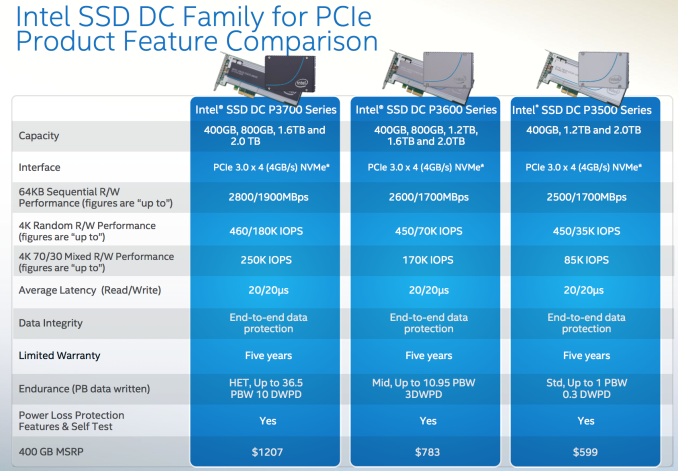The Intel SSD DC P3700 Review Part 2: NVMe on Client Workloads
by Anand Lal Shimpi on June 10, 2014 12:07 AM EST- Posted in
- Storage
- SSDs
- Intel
- Intel SSD DC P3700
- NVMe
Final Words
In the past, high-performance enterprise PCIe drives didn't do all that well in our client test suite. Intel's SSD DC P3700 on the other hand does remarkably well, thanks in no small part to its excellent performance at low queue depths. A continued focus on IO consistency and performance recovery also help tremendously. In our heaviest client workload (our 2013/Destroyer benchmark), the P3700 takes the crown as the fastest SSD we've ever tested.
At $3/GB, the P3700 is a clear fit for enterprise workloads but I can see that being a bit too pricey for even a high end client PC. The real question is how close can Intel's cheaper, lower endurance NVMe drives get to the P3700's performance. The P3500 and P3600 will be available at much lower price points, and may be able to deliver a good portion of the P3700's performance.
Intel won't be shipping the rest of its lineup for a little while longer, but as soon as we get those drives in house we'll provide an update.











36 Comments
View All Comments
[-Stash-] - Tuesday, June 10, 2014 - link
Will be great to see how the 35 and 36 perform in the client workloads – really quite excited about these.romrunning - Tuesday, June 10, 2014 - link
In the 25% OP 4KB Random Write (QD32) graph, the Samsung XP941 showed a massive drop between its 512GB and 384GB (25% spare area) results. From 30k down to 5k - is that an anomaly?Also, what's with the vertical scale showing 1, 10, and 100 ranges? That forces all of the data points into a much smaller range, and it's visually not as informative.
Kristian Vättö - Tuesday, June 10, 2014 - link
Are you sure you are not mixing up the graphs? With 25% spare area, the results are better (~30K IOPS), which is how things should be.romrunning - Tuesday, June 10, 2014 - link
I see - the two charts on the bottom of page one are same but with different vertical scales (as explained so well by DanNeely below).Yes, I suppose instead of calling it a drop, you could say it's actually a rise from 5k to 30k IOPs when you go 25% spare area. It seems Samsung drives especially like extra spare area.
DanNeely - Tuesday, June 10, 2014 - link
It's called a log scale; and generally is the better choice when you've got values spanning more than 2 or 3 orders of magnitude (ie more than 100x or 1000x). A linear scale would crush everything but the largest values into a tiny area at the bottom. With the highly consistent performance of the DC P3700 it's not as big a concern; but with the less consistent behavior of most consumer or older enterprise drives it's the only good way to see the behavior. Look at the Samsung 840; it has peak IOPS of ~100,000; drops to a steady state behavior mostly between ~3000-9000 but with occasional excursions as low as ~110.Also, the tests are being done to show consistency of performance, a log scale makes seeing that much easier because the same vertical distance between min and max always represents the same multiple (eg 2x 3x 10x) between the values; a linear scale would mask inconsistency in slower drives while exaggerating it in higher performing ones because because 20000-22000 is a much larger interval on a linear scale than 10-1000 despite the former being a highly consistent drive with 10% variation and the latter having a 100x variation.
ryanjacoby2 - Tuesday, June 10, 2014 - link
I'm enjoying the pivotchart type graphs you guys transitioned to a while ago. Makes readability and comparisons a breeze without the clutter, thanks for the change!uruturu - Tuesday, June 10, 2014 - link
why don't you test the same drives also with 25% OP in storage bench 2013?samsung 840 pro (25% OP) vs sandisk extreme II (25% OP)...factory settings seem to penalize some drives.
morganf - Tuesday, June 10, 2014 - link
I thought the same thing. The 2013 storage bench writes an insane amount of data in a short time. If someone really cares about performance with such a heavy write-load, then they would certainly overprovision their SSD. The P3700 obviously already comes from the factory with a lot of OP. It only makes sense to also OP the Samsung 840 Pro and other drives, as a point of comparison, when running the 2013 Storage bench.To be clear, I mean to run the 2013 Storage Bench on each SSD with and without OP.
eanazag - Tuesday, June 10, 2014 - link
When's the Intel giveaway for the P3700?extide - Tuesday, June 10, 2014 - link
LOL! Yeah, SIGN ME UP!! Haha ;)